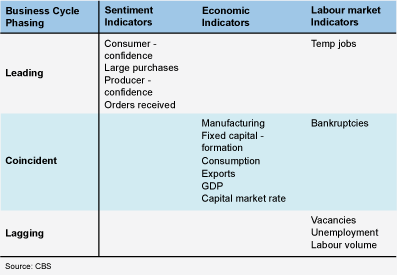The Business Cycle Tracer: leading, coincident and lagging indicators

Since 2005, Statistics Netherlands has been monitoring the state of the Dutch business cycle with the aid of the Business Cycle Tracer (BCT). The BCT is based on 15 indicators. The individual changes in these indicators are published in the Business Cycle Dashboard. On the dashboard the indicators are divided into three macro-economic clusters: confidence, economy and labour market.
To analyse the business cycle, it is also important to know how the 15 indicators relate to each other in terms of time. This is also called business cycle phasing. To this end the indicators can be divided into leading, coincident and lagging with respect to upward and downward movements in the business cycle. The extent to which amount each indicator leads, coincides or lags is calculated by correlating it to the Business Cycle Tracer Indicator (see Box 1). This indicator is the unweighed arithmetic mean of the fifteen indicators.
The relevance of business cycle phasing for macro-economic topicality
As a rule, leading indicators are the first to show which way macro-economic activity is headed in the medium term. It is sometimes therefore important to look at these indicators first in the BCT. Normally they move into a subsequent phase an average six months earlier than the coincident indicators. There are 5 leading indicators in total, of which 4 are confidence indicators. This is logical, because as a sentiment factor, confidence in the economy will adjust to the business cycle more quickly than the physical economic and labour market indicators (production, unemployment, consumption, exports, bankruptcies, etc.). The 5th leading indicator is temp hours. Because of its temporary nature, work via temp agencies can also adapt to economic circumstance more quickly.
Coincident indicators correlate most closely in time with the upward and downward movements in macro-economic activity. There are 7 coincident indicators in the BCT, of which 6 economic and 1 labour market indicator (bankruptcies). The coincident indicators are very important for the BCT, as they provide the hard information for a reliable up-to-date picture of the Dutch business cycle.
Lastly, there is the third group, the lagging indicators. In the BCT these lagging indicators are the second confirmation that the business cycle has moved to or is in a next phase. And it is no coincidence that the 3 lagging indicators are all labour market indicators: labour volume, job vacancies and unemployment. As a result of the strict labour regulations in the Netherlands, it takes some time for the rigid labour market to adapt to changes in the economy. Compared with the other two groups, the movements of the lagging indicators are the calmest. And this is exactly why they are included in the BCT. Once they begin to change, there is no doubt about the way the economy is headed (see Box 2).
The BCT indicator shows the state of the business cycle in one figure. The leading indicators will have shown this on average six months earlier. They should be seen as the quick business cycle indicators. But it is the coincident indicators that show the actual changes in the business cycle. The role of the lagging indicators is mainly to confirm the durability of the business cycle changes. This is important because the course of the cycle is not constant but variable.
Leading, coincident and lagging business cycle indicators

Phasing of BCT indicators

Box 1 Time differences for leading, coincident and lagging indicators in the BCT
Box 2 The role of lagging indicators
Another example of the relevance of lagging indicators can be seen in 2004-2005. The temporary decline of the leading and coincident indicators coincided with hardly any changes in the lagging indicators. This meant that the required second confirmation of economic recovery did not take place. The course of the business cycle was not strong enough to affect the labour market. The leading and coincident indicators improved in the second half of 2005. The lagging indicators followed with their normal delay, removing any doubts about the recovery.
Roberto Wekker